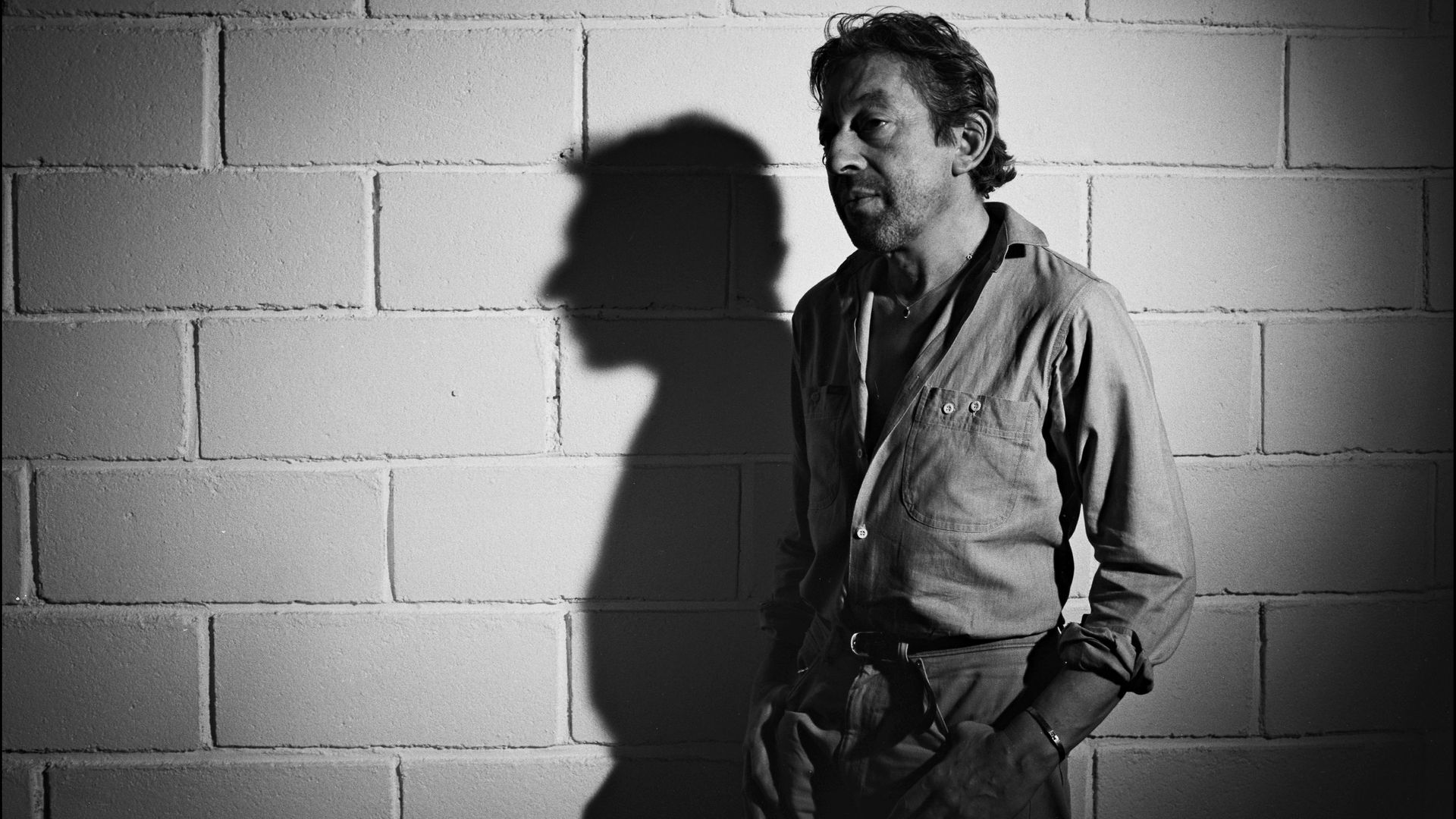
He always set out to shock, but is Serge Gainsbourg now just too creepy for modern sensibilities?
When Serge Gainsbourg died in 1991, Francois Mitterrand, then president of France, declared “he was our Baudelaire, our Apollinaire”. Parisians took to the streets for candlelit vigils and recitations of Gainsbourg lyrics. It was an unofficial day of national mourning.
For the rest of the world outside Paris, comparisons with poets are less instructive. Gainsbourg was France’s Bowie, Jagger, Lennon and Sid Vicious, rolled like a cigarette into one pungent, punning personality. Yet still, the name and the music of Serge Gainsbourg was, for a long time, likely to be met with the most Gallic of shrugs from the non-Gallic world.
“He’s a guilty pleasure all right,” admits Jeremy Allen, author of a new book Relax Baby Be Cool: The artistry and audacity of Serge Gainsbourg. “I’m not sure quite what he’s guilty of, but he definitely crossed many lines in his time.”
So what, then, is all the fuss about Serge? In the UK, he’s still best-known for having a number one record that was banned by the BBC, and the Vatican. Nobody knows if it was the ban and the attendant controversy that boosted sales of Je t’aime… moi non plus in 1969, or if it was the whiff of scandal about his relationship with his girlfriend and co-singer on the record, Jane Birkin.
Rumour had it that they had actually recorded themselves having sex for the moaning and sighing on the record. “If that was true, it would have been a LP, not a single,” retorted Gainsbourg. They were, according to Allen’s book, “for a few months, Europe’s most notorious couple”.
Theirs was the first banned song to reach to the top of the charts (it was there for the day of my birth, which I’ve always been rather pleased about) and the first song not in the English language to do so.
Gainsbourg had originally written it for Brigitte Bardot and recorded a version with her in 1968 but her husband of the time, Gunter Sachs, found it disgusting and she begged him not to release it, for the sake of her marriage. Gainsbourg and Birkin, who met on the set of a film called Slogan, recorded it in London, in a booth off Marble Arch. And they were real-life lovers for 13 years after that.
Is that what made Serge cool, his alliance with a lithe product of “swinging London”, a model and actress who’d appeared naked in Antonioni’s hip movie Blow-Up?
“Serge was cool,” says Allen, “but he always had an underlying uncoolness about him. I found that whenever you identify one thing about him, it comes hand in hand with an almost opposite contradiction. The more you find out when you research him, it just provokes more questions. He’s a man who created his own myth so he’s unknowable really, that’s what I discovered. You really don’t know what was going on in his head.”
Gainsbourg made 30 albums, wrote more than 550 songs, directed four movies and became a national treasure. His house on Rue Verneuil will be turned into a museum later this year.
Following years of delay and procrastination by various Paris mayors and ministers of culture, Serge’s daughter, the actress Charlotte Gainsbourg has paid for the necessary extensions and refurbishments herself, purchasing adjacent buildings to acts as ticket kiosks and toilets and even a shop.
The rest of the museum is the house, exactly as it was the day Serge died, even down to the ashtrays, the bottles of cologne, the wine bottles – some opened – and even the cans of food in the cupboards.
Photos of beautiful women with whom he worked and sung – including Bardot, Marianne Faithfull, Anna Karina, Juliette Greco, Catherine Deneuve, Francoise Hardy, Vanessa Paradis – adorn the walls.
Charlotte and her mother Jane Birkin have jointly kept the house like a bohemian shrine, in that preserved state, like a “house of curiosities”, says Allen, until the public can be let in, although quite how it will be able to keep track of all the knick knacks and artefacts is not known.
The house may provide the ultimate clues to the riddle of exactly who Serge Gainsbourg was. “He’s just not an easy character to sum up,” says Allen, whose book focuses strongly on the man’s music. “The contradictions are what make him so interesting, so that in a way everyone has their own Gainsbourg, and projects their own feelings onto him.
“I say to people: What music do you like? Reggae? Jazz? Rock? Hip Hop? Serge has got an album for you. I see him as a collection of characters: the son of Russian refugees who had to wear the yellow star in 1940s occupied Paris; Julien Grix (a nom de plume) the failed barfly of the intellectual jazzy existentialist Left Bank, then Gainsbourg who tries many styles from winning Eurovision in 1967 to being banned by the Pope five years later, and eventually singing a skanking version of the French National Anthem; and then Gainsbarre (another nom de plume), a foul-mouthed pest, really, who went about causing scandal on TV and rolling around drunk telling Whitney Houston he wants ‘f**k her’ live on France’s top-rated chat show. But he says that was a mask. I think it was all a mask.”
Allen, a well-known music writer, does much to put Gainsbourg’s music, in particular, on a pedestal, with praise from and interviews with artists as diverse as Jarvis Cocker, Chilly Gonzales, Nile Rodgers, J Dilla, Will Oldham (aka Bonnie Prince Billy), Johnny Marr, Sebastien Tellier, David Holmes, Baxter Drury and Sly Dunbar, the legendary producer who cites Gainsbourg’s Aux Armes et Caetera as being “one of the top five reggae albums of all time”.
Was all this character-shifting just the product of someone in restless pursuit of artistic perfection, or someone looking for a hit? “He actually wasn’t a great success in the 1970s,” notes Allen. “The album so many artists now revere, the History of Melody Nelson from 1971, was a flop. He was usually found on Saturday night telly writing songs for Sylvie Vartan, silly throwaway stuff he didn’t even register with SACEM (the French equivalent of our music cataloguers PRS). But in the background, he was making very cool, very transgressive albums…about bums, about Nazis, about sex.
“You get the sense of someone who wants to be loved and be famous and popular, but when he gets near it, self-sabotage kicks in. When he recorded the Marseillaise to a reggae beat with black musicians in 1978, it was probably a nod to the Sex Pistols’ God Save the Queen and to Jimi Hendrix, who he loved, who did Star Spangled Banner, so I think he was going for controversy again. But even that backfired and instead, that album, Aux Armes Et Caetera, became a huge hit and re-ignited interest in him for a new generation of French youth and he was properly France’s biggest star, for the first time perhaps, aged 50.”
Reading the book and looking back on the entrenched status of Serge as a great Frenchman, I wonder if his position mightn’t be under threat from the current political climate of cancelling and #MeToo or, as the movement is known in France #balancetonporc – ‘squeal on your pig’.
After all, Gainsbourg did shock even the French with his song Lemon Incest, which he recorded with his daughter, Charlotte, when she was 13. The title is a pun on on lemon zest, but that really doesn’t explain the video (you can see it on YouTube) of Serge lying on a bed, shirtless, with young Charlotte in nothing but a shirt lying on his chest, singing about “the love we will never make together is the most beautiful and the most disturbing”. She looks almost lobotomised, desensitised, drugged, almost.
Two years later, Gainsbourg was at it again with his daughter, filming her dancing naked in a mirror in the much derided film Charlotte for Ever. “I watched it on my laptop for writing my book,” recalls Allen, “and when I finished I looked out of the window half expecting the police to show up.”
However, in Allen’s book, Charlotte now admits about the song and the movie: “I don’t think we would be able to do it again now… I think he would be described as misogynistic and disrespectful. A lot of the scenes in that film made me feel uncomfortable. I didn’t want to be naked, I did’t want to share that private thing we had on film.”
Yet she also adds: “I think it’s sad those things can’t exist now. I think we need that provocation. I don’t think it’s possible, but I want to believe we could accommodate his provocations now.”
Contrary to, say Woody Allen, whose daughter Dylan is hell bent on bringing him down for alleged historical abuse, Charlotte is not suffering in the same way. Rather she has inherited her father’s sense of provocation, appearing full frontally naked on screen for arch provocateur Lars von Trier in controversial and challenging films such as Antichrist and Nymphomaniac.
“He said things that make me realised how much he loved me,” she says of her father in the book. Amateur psychiatrists and outraged tweeters these days may well clamour that his abuse runs deep, the post-traumatic ripples echoing still, as evidenced by Charlotte and Birkin eulogising about him, keeping his flame alive, not touching the stuff in the house for fear of his retribution and temper. “He would know if anything were even an inch out of place,” Charlotte has said of her father.
According to Allen: “It’s all very French. Serge was let off the hook by the age-old tradition enshrined in French culture where the right to make art, no matter how transgressive, is protected. But there’s no doubt he had a Lolita fixation – he was obsessed by Nabokov’s book, wanted to make the movie, made all his female co-singers use a high-pitched, child-like voice, until he finally used Charlotte and Vanessa Paradis to that end.
“But he was about waking people up, shocking them, seeking attention, although he says he used characters to sing his songs – he can hide behind these and the public rarely conflated them with his real persona. I supposed they could do so now and his legacy could well be under threat from a reassessment.”
Debauched, irreverent, crude, genius, alcoholic, poet, romantic, cynic, louche, lush, painter, film maker, singer, crooner, writer, lyricist, performer, smoker, drinker, artist, collector – Serge Gainsbourg was all of these things. He was ugly, but had affairs with some of the most beautiful women in the world. He got away with it.
Perhaps if he were still alive, he’d be in for the rough ride now being dished out to Polanski and Woody Allen, although as Jeremy Allen points out, there’s no evidence anywhere of any case against Serge Gainsbourg being guilty of anything.
“The most you can accuse him of is treading the line, crossing it occasionally,” says Allen. “And of being an enigma, sometimes brilliant, sometimes pathetic. But always fascinating. There’s just something about his music, his voice, that makes you want to know more.”
In life, and even in death, Gainsbourg continues to make us ask questions of our culture and of ourselves.
Relax Baby Be Cool: The artistry and audacity of Serge Gainsbourg by Jeremy Allen is published by Jawbone Press
What do you think? Have your say on this and more by emailing letters@theneweuropean.co.uk










